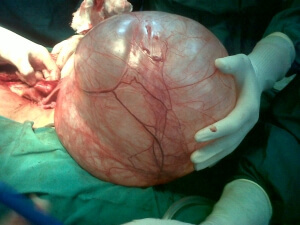Urgent admission to gynecology

The incidence of acute gynecological diseases, when hospitalization is required, varies widely enough. Timely hospitalization in gynecology and diagnosis, as well as adequate provision of first qualified care are the key to effective treatment of patients. Let's consider, in what cases on gynecology urgent hospitalization is necessary.
Dysfunctional uterine bleeding
Urgent hospitalization is necessary for juvenile uterine bleeding. One of the reasons for the bleeding of the puberty period is blood diseases with disorders in the hemostatic system. Often such uterine bleeding uterine bleeding are the first symptoms of idiopathic autoimmune thrombocytopenic purpura( thrombocytopenic purpura is a disease), hemophilia C type, etc. hemorrhagic diathesis.
When uterine bleeding reproductive period required hospitalization gynecology. The basis of violations of cyclic processes in the hypothalamic-pituitary-ovarian structures are disorders of hormonal homeostasis and the receptor apparatus of the ovaries, diseases of the endocrine glands, abortion, neuroendocrine disease, stress, infections, intoxication, iatrogenic influences. In many ways, the clinical picture is determined by the duration of bleeding and the amount of blood loss. Diagnosis doctors spend with the pathology of pregnancy( placental polyp, abortion, ectopic pregnancy), polyposis, adenocarcinoma, uterine myoma, adenominozom.
Uterine bleeding in the climatic period during diagnosis has a clear oncological orientation. All patients are subject to urgent hospitalization.
Emergency hospitalization for acute abdomen in gynecology department
It is a syndrome that develops as a result of acute pathology in the abdomen, in which there is a sudden stomach pain. Acute pain in the lower abdomen with pronounced peritoneal symptoms can occur with intra-abdominal bleeding. This apoplexy of the ovary, ectopic pregnancy, torsion of the legs of the ovarian cyst, pelvioperitonitis, perforation of purulent tubo-ovarian formations.
For ectopic bleeding, hospitalization is urgently needed. When the fallopian tube is broken, blood from the damaged vessels enters the abdominal cavity. Usually the bleeding is massive. Differential diagnosis includes wired gastric ulcer, duodenal ulcer, acute pancreatitis, acute appendicitis, and so on. For the diagnosis need directions to delay menstruation, spotting, subjective signs of pregnancy.
Ovarian apoplexy is an ovarian infarction, an ovarian rupture, an ovarian hematoma. This acute violation of the integrity of the ovary, when there is a hemorrhage in his stroma and subsequent bleeding into the abdominal cavity.
Unlike an ectopic pregnancy during an ovary rupture, there are no signs of pregnancy, indications of a delay in menstruation, spotting. With apoplexy of the ovary, urgent hospitalization is needed in a multidisciplinary hospital. At the slightest signs of internal bleeding, urgent administration of blood substitution solutions is required.
Torsion of the leg of the ovarian cyst is a complication of the cyst or ovarian cyst. Torsion can develop acutely or gradually, with a circulatory disturbance, usually with cyst edema, necrosis of the parenchyma and hemorrhage.
Differential diagnosis is performed with a disrupted ectopic pregnancy and with acute appendicitis. Urgent hospitalization of a woman is necessary. Treatment at the prehospital stage is not carried out.
Perforation of purulent lesions in the appendages of the uterus takes a leading place in gynecology and remains a more common reason for urgent hospitalization. Microbial invasion is the main mechanism of the development of the disease. Precipitating factors iatrogenic factors( surgery, abortion, hysteroscopy, intrauterine devices, in vitro fertilization) or physiological factors( menstruation, childbirth).Iatrogenic weakening or changes in the barrier properties of the genital tract and uterus, which contributes to the formation of a "gateway" for pathogenic microflora, and its further spread. There is infection with intrakanalicular, hematogenous, ascending and lymphogenous pathways.



